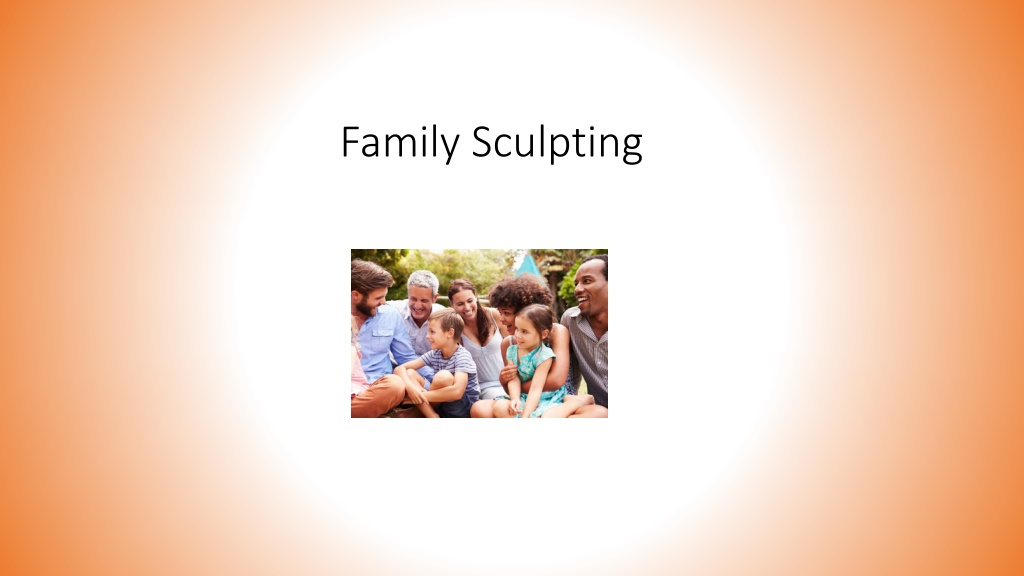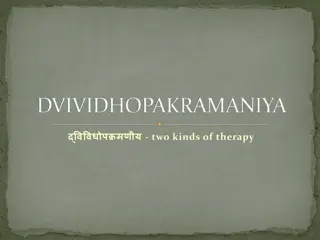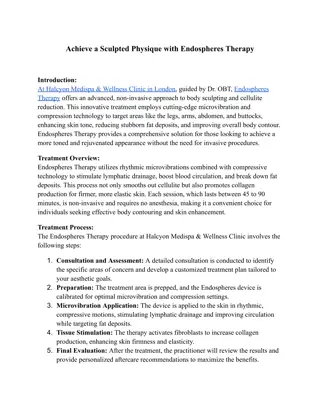Understanding Family Sculpting in Therapy
Family sculpting is a unique form of family therapy where trained therapists use psychodrama techniques to explore and address deep family dynamics. Through verbal and nonverbal expressions, family members are placed in scenes that reflect their roles and attitudes within the group. The sculptor, typically a family member, arranges the family in a way that reveals underlying issues. Child-centered family therapy focuses on both children and adults, helping to heal past family trauma. In this approach, the identified client, often the one blamed for family issues, may take on the role of the sculptor.
Download Presentation

Please find below an Image/Link to download the presentation.
The content on the website is provided AS IS for your information and personal use only. It may not be sold, licensed, or shared on other websites without obtaining consent from the author. Download presentation by click this link. If you encounter any issues during the download, it is possible that the publisher has removed the file from their server.
E N D
Presentation Transcript
What is Family Sculpting? What is Family Sculpting? When we think of family counselling, we imagine our family sitting in a room with a counsellor, talking things out. Although therapists often conduct family meetings in a standard 'talk' format, family therapy can take many other interesting forms as well. One of these forms, family sculpting, is a technique that reveals family dynamics through verbal and nonverbal expression.
Family Sculpting Definitions Family Sculpting Definitions Family sculpting is a specific type of therapy that needs to be done by a therapist trained in the technique. Deep issues arise that need to be addressed by someone who understands family sculpting very well. What is family sculpting? Family sculpting is a type of psychodrama used in family therapy. Family sculpting is also one of the child-centred therapies that can be used in a group setting. A member(s) of the family is chosen as a sculptor(s). The job of the sculptor is to place the family in a scene that reflects each person's position, attitude, and role within the group.
Psychodrama Definition Psychodrama Definition As a type of therapy, psychodrama is a dramatic representation of past (or future) events. In other words, the people involved in the group act out memories or projections. In a sense, the sculptor of a family sculpting session is the director of this play, although there might not be any movement involved.
What Is Child What Is Child- -Centred Family Therapy? Centred Family Therapy? Child-centred therapy is, of course, a therapy that focuses on a child. In this definition, the child or children in question may include adults. When adults are a part of the group, therapy focuses on their inner child. Child-centred family therapy is for many kinds of families, as well as for adults who came from dysfunctional families.
Who Is the Sculptor? Who Is the Sculptor? The sculptor is typically a family member. It can be an adult or a child if they're old enough to follow the simple directions for sculpting. The sculptor is the one who arranges the family.
Who Is the Identified Client? Who Is the Identified Client? The identified client is a term used in family therapy. The identified client is the family member who other family members blame for the family problems. Often, the identified client becomes the sculptor in family sculpting. The identified client is a somewhat controversial term because it seems to indicate that the person who takes the blame is the one who is disturbed rather than the entire family. However, some therapists who use family sculpting still use this term. Family therapists are trained to understand the complexity of family dysfunction. Experts in mental health understand that there is no one person who is the source of all problems.
How Family Sculpting Works Sometimes, new experiences seem less frightening or uncomfortable if you know a bit about what to expect. While you should do family sculpting under the supervision of a counsellor, knowing more about it before you begin may help you feel more relaxed and positive. Your therapist will explain what's about to happen before you begin.
1. 1. Choosing the Sculptor Choosing the Sculptor The first task of family sculpting is to choose a sculptor. Usually, the therapist simply asks who would like to do it. The counsellor may ask the family member if they feel emotionally ready to take on this role. If more than one person wants to be a sculptor, the counsellor may ask more questions to decide or may allow both to work together with one acting as a lead sculptor. 2. 2. The Sculpting Process The Sculpting Process The therapist usually starts with a specific prompt. They may ask the sculptor to place the family according to the way he thought of them when she or he was a specific age. Or, the therapist may ask the sculptor to position the family the way they seemed to her or him before, during, or after an event. Next, the sculptor follows the prompt. He or she might put some people closer together than others. Two people might be holding hands or pushing each other. The sculptor may add details such as tilting one of their heads up, so their nose is in the air to indicate that the person feels superior. The sculptor determines all the positions and details.
3. 3. Therapist Interventions Therapist Interventions The therapist may need to intervene at certain points during the sculpting. If an argument arises, the therapist can help the family resolve the issue together. Sometimes, psychodrama can uncover long-buried feelings that are so intense the sculptor isn't able to go on with the sculpting. When these feelings come up, the therapist can help the sculptor work through them. Even the family members who are simply standing as the sculptor posed them may become aware of feelings, thoughts, and problems that seem overwhelming. The trained therapist steps in to help the family understand their situation better, express their emotions, and begin their healing process. 4. 4. De After the family is sculpted, a brief talk session follows. They discuss what everyone discovered. The counsellor helps them leave behind the roles the sculptor placed them in and begin to feel more comfortable and more like themselves again. De- -Rolling Rolling
Purposes of Family Sculpting Purposes of Family Sculpting Family sculpting can help your client and their family in several ways. Assessment/Diagnosis Assessment/Diagnosis The therapist uses the information they gain during an initial family sculpting session to diagnose the problems in the family so that they can offer the best treatments. They may use later sessions to assess how members are doing individually and as a group at different points in the family therapy. This helps them know if they need to make changes in the treatment or if the family has accomplished all of your goals within the therapy.
Therapeutic Technique Therapeutic Technique Family sculpting isn't just for assessments. It's a way for families to connect with their inner children, with their feelings, and with each other. It is a therapy that can be used to help a family resolve its problems and become mentally healthier and more functional. Advantages of Family Sculpting Whether your therapist uses family sculpting alone or with other treatment modalities, this form of therapy can be helpful for several reasons. It has advantages that many other types of therapy can't match. Experiential Experiential Doing a family sculpt may be more intense than only talking about your family problems. When you take the role of the sculptor, you are touching, positioning, and posing each family member. When you take the role the sculptor gives you, you feel the pressure of their hands moving you. Family sculpting is an active experience that you feel in your body.
Concrete Concrete Family sculpting is a concrete and visual modality. The family dynamics, at least as the sculptor sees them, become so obvious that not only does the therapist understand, but the family members learn from what they see. In addition to the sculpt itself, the verbal and nonverbal exchanges between family members, while the sculpt is going on, are also easy to notice. During talk therapy, family members can intellectualize their problems and rationalize their behaviour. It is harder to deny what happens in therapy with everyone watching. Immediate Immediate Family sculpting is sometimes the quickest way to address the heart of family dysfunction. When people see how the sculptor has placed them and others, they can immediately identify how they feel. Or, if you are the sculptor, you can express your feelings about the family structure in a very short time. Family sculpting offers a shortcut to uncovering truths about your family.
Emotional Emotional Some people become very emotional during talk therapy. However, many others simply say the words that make them look better or seem the sanest. Family sculpting brings up feelings family members may not have even realized were inside them. They not only experience their feelings, but they have a chance to express them in the family group. Uncovers Hidden Problems Uncovers Hidden Problems Family sculpting is a good way to discover problems that none or few of the family members are aware of. As the sculptor is arranging the family members, everyone may notice that he or she unusually placed someone. The sculptor may not even have a reason for why they did it that way. As the therapist helps the family get to the bottom of this sculpture and work through the problem as revealed, the family becomes more self-aware. They have new information that may help them become healthier and stronger.























